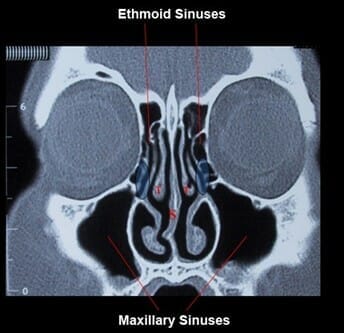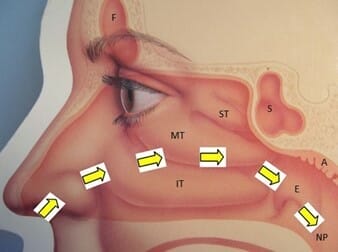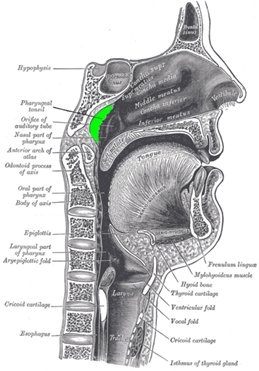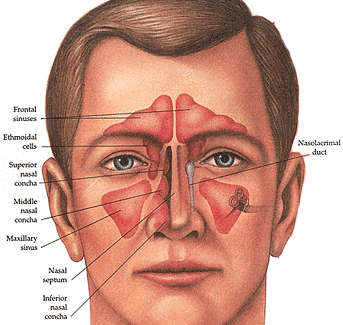The Paranasal Sinuses
The nose paranasal sinuses (“the sinuses”) are air-filled cavities located within the frontal bone of the face. Each sinus is named for the bone in which it is located. Note the sinus description anatomy and the sinus drainage anatomy.
Maxillary sinuses: One sinus per side, located within the cheek bone (See Figures 1 & 2).
Ethmoid sinuses: A honeycomb-like structure of 6-12 small sinuses, located between the eyes. Although often shown as a single sinus in diagram of nasal passages and sinuses (See Figure 1 facial sinus cavities), the ethnoid sinuses are better appreciated on CT scan images (See Figure 2).
Frontal sinuses: One sinus per side, located within the bone of the forehead (See Figures 1 & 3 four sinus cavities diagram).
Sphenoid sinuses: One sinus per side, located behind the ethmoid sinuses. The sphenoid sinus can be seen when looking at a side view (See Figure 3).


The Nasal Cavity
The pink membranes lining the sinuses are called mucosa. Mucosa make mucus which is then moved out of the sinus cavities and into the nasal cavities. Along the sides of the nasal cavity there are shelves of bone called turbinates. The turbinates, which are also covered by mucosa, help humidify the air that you breath. There are generally three turbinates (inferior, middle, and superior) on each side. Most of the sinuses drain into a common outflow pathway, just beyond the middle turbinate. This region is called the osteomeatal complex (See Figure 2). When you breath in, air flows between the turbinates and the nasal septum. Made of cartilage and bone, the nasal septum separates the two sides of the nose. Both air and mucus are eventually moved to the nasopharynx (See Figure 3). This is where the back of the nose meets the top of the throat. Air is then breathed into the windpipe and lungs, while the mucus is swallowed (See Nasal Physiology).
Additional Related Structures
Other important structures near the sinuses include:
Tear duct (nasolacrimal duct): drains tears from the inside corner of the eye into the nasal cavity (See Figure 1).
Eustachian tube: the tube responsible for equalizing pressure in the ears opens into the nasopharynx (See Figure 3).
Adenoids: a collection of tonsil-like tissue that is found at the top of the nasopharynx (See Figures 3 & 4). Although adenoids can be large in children, this tissue usually goes away during puberty.

Copyright © 2020 by the American Rhinologic Society

